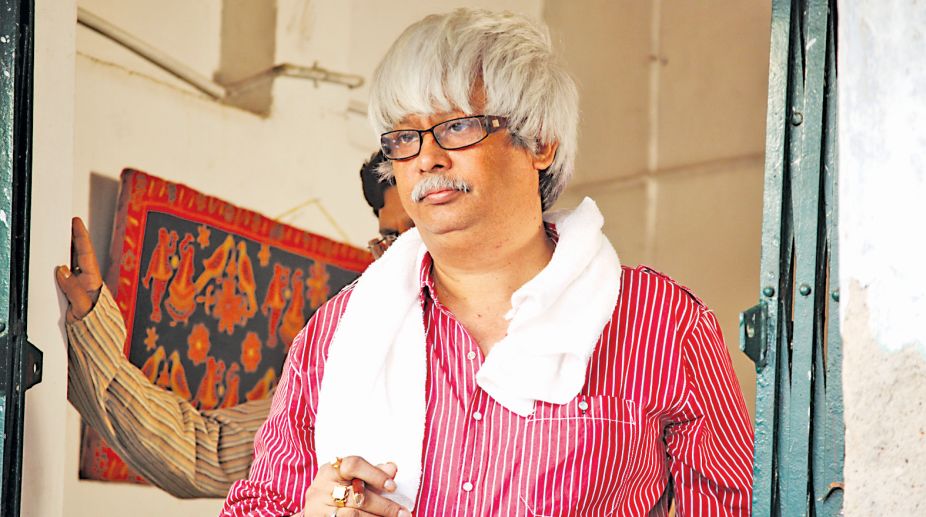Haranath Chakraborty is an institution unto himself. Intellectuals scoff at his kind of cinema but statistical data on some of his commercial hits spell a different story. His new film Dharasnan released in the city recently.
He talks about this out-of-the-box film as he moves back to his long track record of churning out masala hits, one after another, for nearly three decades. A much-mellowed and totally grounded Chakraborty with his silver mane opens up in this interview. Excerpts:
Q. Dharasnan, you have repeatedly said, veers away from the genre your audience knows you for. Why?
Ullas Mullick’s story appealed to me. It is out-of-the-box and posed a challenge. The shooting was completed in 2013 and post-production finished in 2014. We had a three year wait to get it released.
I decided that too many song and dance numbers would spoil the spirit of the film. I did retain one as a relief but otherwise, the film is really different from what my audience identifies me with.
Q. You have picked Kanchan Mullick, an excellent actor reduced to doing comedy, to play the male lead opposite the glamorous Rituparna Sengupta. Why?
He looks exactly as the character in the novel. Shantosheel, portrayed by Kanchan, is always very sick. He is also filled with guilt because he knows that his wife Tomosha (Rituparna Sengupta) was fooled into marrying him and was forced to become the breadwinner of the family.
She appears to hate the sight of her husband but takes care of him without him being aware of it. You must watch the film to see Kanchan’s performance. I have not taken any liberties with the original work.
Q. Are you happy with the film?
The long wait for the theatres to release the film has been frustrating. We worked very hard — from the newcomer Disha Ganguly in a parallel role to Biswajit Chakraborty who plays a very important role in shaping Tomosha’s financial success as a businesswoman.
I discussed the music at length with Debajyoti Misra. It has turned out just the way I wanted it. The USP lies on that it reverses the gender roles between the husband and wife with the wife taking on the responsibility of the family while the chronically sick husband is forced to live off the tit-bits she throws his way.
Q. Let us take a ride into your past journey as director.
I began as an assistant to Anjan Choudhury in 1983. I consider him my mentor. My directorial debut was with Mangal Deep starring Ranjit Mullick and Sandhya Roy. Critics said that the film’s treatment, plot and theme were similar to that of Anjan da’s and I took that as a compliment.
Q. You are said to have brought in several innovations in terms of technique in Bengali cinema. Will you elaborate?
With Nabab (1991), Sangharsha (1995), Mahan (1996), Bidroha (1997) and Ranakshetra (1998), I had found my roots in the industry and created my own audience. Every single film I made managed to ring success at the box office.
They were action films. This became a genre I specialised in. I think I was the busiest director in the 1990s and early 2000s.
Ranakshetra brought in several changes. I shot the film at a much higher budget than what was prevalent in Tollygunge. The action sequences were orchestrated and choreographed in much detail. The blast and chase sequences involved expensive cars.
Q. How were you so prolific in your filmmaking both in terms of the number of films you directed as well as the frequency with which they were made?
I did not believe in keeping a gap of more than a few weeks between two films because I believed that my crew should always be working. This would generate revenue for the industry and also its workers and this was necessary for an industry to survive.
Q. Let us hear the history that Shasurbari Zindabad made in 2000?
It had several USPs, which felt like risks to many. It was shot with the biggest budget till then in Tollygunge. It was the first film to have been shot in cinemascope. We had a costume designer, publicity designer, an official music release and a digital poster.
It became a massive hit across cities in West Bengal and in small towns and villages. It resurrected the pairing of Prosenjit and Rituparna who had given only one hit out of their eight releases the year before.
This film brought them back to the box office. For the first time, 50 prints of the film were released simultaneously in Bengali cinema.
Q. But the critics did not like it we hear?
Yes. They lashed out at me for making Bengali films look like cheap imitations of Hindi masala films and frame-to-frame copies of South Indian films. They failed to understand that these were the very factors that made my films both popular and commercially successful.
The facts proved me right. The film made on a budget of Rs 70 lakhs, recovered the entire amount in just about 50 days — unbelievable within Bengali cinema.
It was the first time in Bengali cinema that a film made so much money. It ran under “House Full” signs in more than 25 cinema halls across Bengal. Till then, the industry was experiencing huge financial losses and a blockbuster was the need of the hour.
Hall owners were beginning to sell off their properties or lease them out since 1999 and studio owners were talking to promoters. This film broke the jinx and Bengali cinema was on its feet again.
Q. This film also motivated a corporate brand for its own marketing. Right?
Pantaloons cashed on the success of Shashurbari Zindabaad and came up with a slogan during the Bengali festival of Jamai Shoshti.
It was possibly the first recognition of a mainstream film and the Bengali film industry by a corporate brand.






